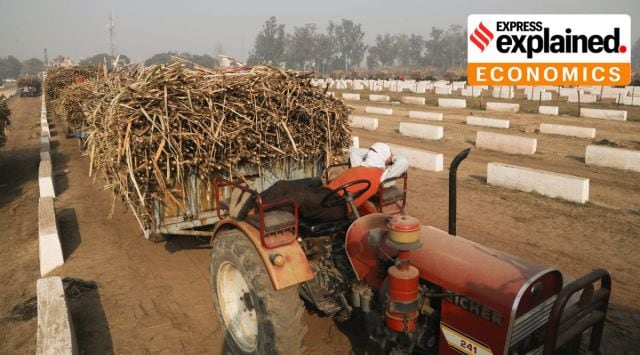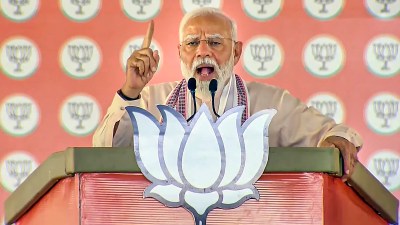- India
- International
Explained: Why has Centre advanced its 20% ethanol blending target by five years?
The Union Cabinet has advanced by five years its target for achieving 20% ethanol blending in petrol. What does advancing the blending target mean? Is the new target achievable? What are the roadblocks ahead?
 After setting a 20% blending target for 2030 initially, the central government had announced premium rates for ethanol produced from sugar syrup, cane juice as well as B heavy molasses.
After setting a 20% blending target for 2030 initially, the central government had announced premium rates for ethanol produced from sugar syrup, cane juice as well as B heavy molasses.
The Union Cabinet Wednesday advanced by five years its target for achieving 20% ethanol blending in petrol. The amended National Biofuel Policy-2018 has now set the new target for 2025-26 instead of 2030, apart from allowing more feedstock for production of biofuels and export of biofuels in specific cases. A closer look at the amendments and what they mean for the sugar industry.
What is the biofuel policy?
Introduced in 2018, the National Biofuel Policy is aimed at reducing dependence on imports by encouraging fuel blending. With bioethanol, biodiesel and bioCNG in focus, its key parts include Ethanol Blending Programme (EPB), production of second generation ethanol (derived from forest and agricultural residues), increasing capacity for production of fuel additives, R&D in feedstock, which is the starting material for ethanol production, and financial incentives for achieving these goals.
After setting a 20% blending target for 2030 initially, the central government had announced premium rates for ethanol produced from sugar syrup, cane juice as well as B heavy molasses. Molasses is the sticky liquid formed during sugar production from cane juice, and depending on the percentage of sugar left, it is categorized as B heavy and C. Molasses is the feedstock used by sugar mills to produce ethanol.
The policy also allows usage of excess rice or damaged foodgrains as feedstock for ethanol production.
The National Biofuel Coordination Committee (NBCC), with the Union Minister for Petroleum and Natural Gas as its head, is the agency to coordinate this blending programme.
What amendments have been made?

On Wednesday, the 2018 policy was amended to introduce several changes. The most important amendment has been advancing the 20% blending date by five years from Ethanol Supply Year (ESY) 2030 to 2025-26. Introduction of more feedstock for production of biofuels; production of biofuels under the ‘Make in India’ programme in Special Economic Zones, Export Oriented Units; and permission to allow export of biofuels in specific cases are some other changes. Apart from addition of new members to the NBCC, the Committee has now been given the permission to change the policy which it earlier lacked.
What does advancing the blending target mean?
Given the skyrocketing fuel prices, the blending programme has a dual purpose – to reduce the crude oil import bill and to allow consumers access to environment friendly fuel. For this, Oil Marketing Companies (OMCs) have already been mandated to buy ethanol from sugar mills and clear payments within 21 days. The decision would help sugar mills diversify their portfolios faster from just sugar production and become self-reliant in paying cane-growers.
“This move has the potential to change the face of the sugar industry and make it self-reliant,” said Bhairavnath B Thombare, president of the West India Sugar Federation – the apex body of private sugar mills in Maharashtra.
Is the new target achievable?
Experts believe that achieving the new target is not easy. Prakash Naiknavare, managing director of the National Federation of Cooperative Sugar Factories Limited, said that in order to achieve 20% blending, India would require a consistent supply of 1,500 crores litres of ethanol annually.
Niti Aayog has talked about managing 760 crore liters from sugar and 740 crore litres from grains to meet this ethanol requirement. Once 20 per cent blending is achieved, 60 lakh tonnes of sugar would have to be diverted annually to produce the fuel additive.
What is the current blending status?
As on May 8, the all India average blending as per the Ministry of Petroleum and Natural Gas stands at 9.90%. Letters of Intent for supply of 468.56 crore litres of ethanol were issued at the start of this Ethanol Supply Year (December 2021 to November 2022), out of which 415.88 crore litres has been contracted and 186.21 crore litres supplied so far. Ethanol derived from sugarcane juice/sugar syrup and from C heavy molasses forms the bulk of this supply, with that from surplus rice and damaged foodgrains being a distant second. Around 16 lakh tonnes of sugar was subsumed to produce this ethanol.
At present, the installed capacity that sugar mills have for ethanol production is 460 crore litres, Naiknavare pointed out. It is expected that another 260 crore litres would be added to this once the 46 new distilleries become operational.
These have already been approved under a new financial scheme where Centre provides 6% interest subvention for new projects.
Newsletter | Click to get the day’s best explainers in your inbox
What are the roadblocks ahead?
While several in the sugar industry appear to be upbeat about the early deadline, many cooperative sugar mills have complained about a fund crunch. Banks, they claim, are reluctant to finance sugar mills given their weak balance-sheets.
As a way out, mills have asked for tripartite agreements between OMCs, banks and cane suppliers to clear payments within 21 days. However, most banks have expressed their apprehensions. Naiknavare confirmed the matter was raised during a meeting with the finance ministry officials.
More Explained
EXPRESS OPINION
Apr 25: Latest News
- 01
- 02
- 03
- 04
- 05










































